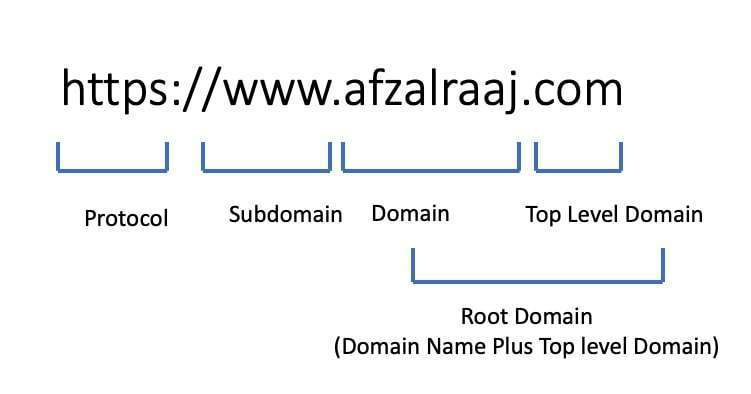A domain name is a unique URL that identifies your website online. The hosting service providers offer space on their servers so that you can upload your website files and make them accessible to everyone on the internet.
These are the two things that you need for your website and hosting. They may seem simple, but they help build a strong online presence.
Ultimate Guide to Domain and Hosting
Selecting the right domain and hosting company is crucial in developing any website. The domain name is what people will use to find your website, so it should be easy for them to remember.
Suppose you’re just starting with a new domain. In that case, it’s important to make sure that you register it with a reputable hosting company that offers prominent features like SSD drives, cross-platform support, and free migrations.
It has been found that when people are searching for your business online, they will type in your web address or domain name before they type in your company name or product name because most people don’t remember URLs or domains unless they have visited them before or if they are very memorable like Google and Amazon.
Therefore, having a good domain name and a fast and efficient hosting service is important to rank higher on search engines and get more traffic to your site, which will help you grow your business faster.
This section will discuss every aspect of the domain, Hosting, and their role in SEO. Let’s start with the following:
Quick Links
Complete Guide to Web Domain
Domain Names are the cornerstone of any online business. They are the first thing your customers will see when they visit your website and form an important part of your company’s identity.
Choosing a domain name is crucial for any company looking to establish its online presence. It will be your customers’ first impression of you, and you must choose a domain name that reflects who you are and what you do.
How to register a Domain?
Domain registration is a process that involves registering a domain name and obtaining the corresponding hosting services. It’s an important step in starting a website or online business.
Before registering a domain, it is mandatory to check its availability. First, research the whois database to see if any domain names are available for purchase. If the required domain is not available, usually domain seller offers alternate names.
You can pick the alternate name or modify, abbreviate or add a new word. For example, the service will give suggestions if you want to purchase afzalraaj.com, but it is unavailable.

Types of Domain
Expiring domains
Expiring domains become available for purchase after a fixed period.
When expired domains become available for purchase, they go through a process called domain flipping.
This process involves buying expired domains to resell them at a higher price.
Purchasing an expired domain for a PBN is a common practice, but there are certain precautions you must take to avoid getting caught.
New Domain
The New Domain is a part of a generic domain name, which has not expired. Usually, the price varies depending upon the provider and the words it consists of.
There are many ways to purchase a new domain name. First, you may buy a domain name from your favorite company, such as hosting, Namecheap, or Bluehost.
If you are an individual, you can also purchase a domain name available on the open market.
Parts of Domain Name
The protocol, subdomain, domain, and Top level domain are the four URL levels. They tell the computer where to find the data.

1)- Protocol Part
The protocol is the first part of the domain, HTTP or HTTPS. HTTP stands for Hypertext Transfer Protocol, and HTTPS is the abbreviation of Hypertext Transfer Protocol Secure.
Most domain and hosting companies offer free secure Socket Layer (SSL) certificates for one year. It is the best option as HTTPS is more secure and reliable.
Google prefer and recommend secure sites and rank them on a priority basis. Though it has a minor impact on ranking position, however, it is necessary to site safety and security.
This security protocol is an important Google ranking factor due to its impact and nature.
2)- Subdomain Part
The meaning of WWW can be found in its historical context, the World Wide Web.
The World Wide Web was originally conceived as a global computer network where computers could exchange information. However, the World Wide Web has since evolved and now refers to the domain name system.
A website is a location on the World Wide Web where a person can find information, services, resources, and other content.
www in the website domain name is the abbreviation for the top-level domain of the World Wide Web. Tim Berners-Lee, a British scientist, invented the World Wide Web (WWW) in 1989.
3)- Domain Name Part
The domain Name part is a term that comes from computer networking. It indicates a name that belongs to a particular portion of a larger domain name. In the case of www.afzalraaj.com, for example, the domain name is guidance.
4)- Top Level Domain
A Top Level Domain is an umbrella term that refers to the two or three-letter codes of the domains you can purchase on the internet. A TLD is usually a country’s two or three-letter acronym, such as .com for commercial or .gov for government websites.
Types of Domain Names
Top-level domains are the dots that appear at the end of a web address. These domains indicate what type of website is on a particular URL.
They are divided into categories such as .com, .net, and .org. Each domain has some form of regulation and has been established by a governing body to ensure safe access. Therefore, we can categorize domain names as below:
1)- Generic Top-Level Domains (gTLDs)
The Top generic level is the last part of the domain URL. These are domains not particularly tied to a specific region or country. For example .com .net .edu .org .gov .io
There are some generic regional top-level domains are also available. Though these domains are linked with a specific region, however, search engines treat them as generic top-level domains (much like .com or .org) .eu .asia
2)- Country code top-level domains (ccTLD)
These domains refer to specific countries (for example, .pk for Pakistan, .us for the USA); hence it signals to the user and search engine that these websites are particularly designed for a specific region.
3)- Generic Country Code Top Level Domains (gccTLD)
Google treats some country-code top-level domains as generic country-code top-level domains.
.ad .as .bz .cc .cd .co .dj .fm .io .la .me .ms .nu .sc .sr .su .tv .tk
SEO Friendly Domain Name
A good domain name should be short, memorable, relevant to the type of business you’re in, and easy to spell. It should also be available as a .com or .co.UK domain name so that it can be easily found by potential customers searching for companies like yours on search engines such as Google or Yahoo!
- – Keyword included: Don’t just choose a domain you like. Instead, pick one that fits your keywords.
- – The shorter, the better: Keep it to the point and concise.
- – Make sure that the domain name is available for .com and .co.UK domains, as well as your country’s ccTLD (country code top-level domain)
- – Don’t forget about abbreviations! If you want to promote your business on social media outlets like Instagram and Pinterest, make sure your domain name includes the initials of your company.
Complete Guide to Web Hosting
A web hosting service is a type of Internet hosting service that allows individuals and organizations to post a website or web page on the World Wide Web. In addition, a web host is an Internet hosting service provider that provides file storage and data transfer services to end-users or website owners.
In other words, they provide servers with access to the World Wide Web. The term “web host” can refer to the organization providing these services or their computer hardware.
Types of Web Hosting
Shared Hosting
This type of web hosting is one of the most affordable, but it has performance limitations, as they are typically shared.
In addition, sometimes they come with only 1GB of disk space and usually no hardware or storage space. This type of hosting is used when you only need to host a few websites.
This is the best option for you if you are starting as an entrepreneur or in your small business.
The downside is that your website will be slower because it’s shared with other people than if it was hosted on its dedicated server.
Managed Hosting
This type of hosting allows users to install and maintain their server, which can be advantageous for a small business or startup that wants to control its own IT infrastructure.
WordPress-managed hosting is another popular sub-category that hosting companies offer for WordPress enthusiasts to upload and manage their websites.
You’ll also have to pay more than if you were going with a dedicated server option or if you were going with cloud-based servers such as Amazon Web Services (AWS) or Google Cloud Platform (GCP).
Dedicated Server
This hosting is generally used by businesses with a bigger budget.
They offer more storage space and hardware than shared hosting but can also be costly.
This type of web hosting offers dedicated resources for each host to use.
This means you will have much more power and control over your site than shared hosting.
However, it will be very expensive and recommended for established agencies and corporations.
The owner has more authority and control over options.
Cloud Hosting
This is the newest type of web hosting.
It provides professional services that can be accessed from any computer, tablet, or smartphone with internet access.
Cloud hosting is the best because it’s affordable, scalable, and secure.
It also saves you time, effort, and money. There are multiple back servers to ensure the smooth and high quality service.
Cloud computing offers many benefits and can be a good choice for companies that need to scale up their services.
However, it is not without its cons and should be used cautiously.
Buying Hosting: Pro Tips
You are supposed to go through below details before selecting a hosting service:
1)- Data Storage Capacity: The amount of data the host can store in gigabytes.
2)- Cost: How much it costs to create a website.
3)- Backup Capacity: The amount of data stored in case the host hard drive crashes (in megabytes).
4)- Open Source Software: The variety of software available for end-users to use without paying fees.
5)- Data Transfer Capacity: The number of times per day a website can be downloaded from the server (approximately).
6)- Bandwidth: How much data can be uploaded in a given period.
7)- Number of Databases: The number of databases the host can store.
8)- Data Protection Features: Does the host offer protection for personal information?
Final Thoughts
The web domain is the URL of a website. It is usually referred to as the website’s address and is often written as www.website.com or www.website.co.uk (for example).
A web host is a company that provides the space on a server for a website to be hosted on the internet so that it can be accessed by anyone with an internet connection, anywhere in the world.
Choosing the best domain and hosting is a tedious job, as you must do a lot of research.
The domain name is the address of your website. The domain name is the URL part that comes before the top-level domain (TLD). So, for example, if your website is called “myfitnesspal,” your domain would be “myfitnesspal.com.”
There are different types of domains and hosting providers that you can choose from based on what you need for your website. Shared hosting might be a good fit if you are looking for a cheaper option.
If you want speed and security, then dedicated hosting might be better suited for what you need.
FAQs
Domain names are the address of a website. It is used to identify the web page on the internet.
A domain name can be any word or string of letters, numbers, and special characters. The most common domain names are words that end in .com, .net, .org, or .edu.
Domain names have a specific structure that includes an extension and a top-level domain (TLD). For example:
www.example-com
www.example-org
www.example-edu
Web hosting is a service that allows people to store and run their websites on a server. It’s also used to provide access to websites for Internet users. There are many different types of web hosting services, which include shared, dedicated, cloud and VPS (Virtual Private Server) systems.
There were two main types of web hosts in the past: ISPs (Internet Service Providers) and Dedicated Hosts. Today, there is more than one type of host available due to advancements in technology. The most popular type of host today is shared hosting because it’s affordable and easy to use.
Web domain registration is a process through which an individual or company can register a domain name to their website. It is the process of registering a domain name that is associated with the website content. A web domain registration usually includes:
– Registering one or more domains with an ISP (Internet Service Provider) such as GoDaddy, Hostinger, Namecheaoetc.
– Creating DNS records for each domain on the ISP’s servers.
– Hosting the website on a server provided by the ISP.
– Configuring your website to use SSL certificates provided by your ISP
– Using DNS provider services such as Cloudflare to provide DDoS protection and other security features for your website
There are many hosting providers that provide different services to their users. A web hosting service is a service which provides the capability to run a website on the internet.
When you purchase a web hosting service, you will be able to create websites, databases, and email accounts on this server. There are many ways of purchasing a web hosting service. and all providers rely on different methods.Many hosting services could be quite similar.
However, all hosts have certain differences in the types of features they are providing to their customers.
Moving your domain to a different hosting service is a common question. Most people are not aware of the different options that are available to them.
Moving your domain to a new hosting service can be done in two ways:
– With an existing domain and hosting account, you can simply transfer the domain to the new account. This is convenient for those who already have an account with the hosting company and want to move their domains over.
– If you don’t have an account with a company and want to sign up for one, this process will be slightly more complicated but still manageable. You’ll need your web host’s email address, username and password in order to complete this process.
Domain and hosting are the two most important factors in SEO. Therefore, companies must have a strong domain name with relevant content and a reliable hosting service.
Domain: The domain is the first impression of your website that users see before they land on it. The domain name should be short, easy to remember, and relevant to your company’s industry or niche. User-friendly URLs and keyword-specific domain name help in SEO.
Hosting: Hosting services are used by companies that need their websites hosted on servers that they control, which means they can optimize them for search engines like Google, Bing, and Yahoo. Page speed, data security, uptime, and other features greatly impact technical on-page SEO.
Sharing is Caring

























